Once upon a time they were numerous, and popular, and had significance in the history of comic books. Then, presto, they were all but gone, sucked into the black hole of the comic book Dark Ages. Outside of nostalgia pieces, only one remains and DC is trying to change even that.
Yes, categories of heroes come and go. Heroes draped in the flag were common during World War II. Post-victory, post-Cold War, post-Watergate, really only the Shield (Red Circle), Uncle Sam (DC), and Captain America and his imitators, the Captain and USAgent (Marvel), are all that’s left. Other than that, from Fighting Yank to Fighting American, they’re all gone.
The same with our category of stage magicians who fight crime with real magic. The common stage tricks like invisibility, making things disappear and reappear, read minds, and above all, hypnotize people were in their armories. Hypnosis was a big thing, and it was the one trick of stage magicians that wasn’t a trick. So it was a standard in magic shows, novels, movies, and movie serials.
Part of the reason for this awareness was Harry Houdini. A noted stage magician, Houdini started with card tricks, moved to escapology, took to hypnosis (particularly self-hypnosis), made movies, then moved on to exposing psychics and spiritualists as frauds, and died in mysterious and tragic circumstances. He kept the idea in people’s minds.
From this mix came the first superpowered crime fighter: Mandrake the Magician. He was created by Lee Falk. Falk was a man famous throughout the world except, mostly, America, for inventing the first non-superpowered, costumed crime fighter, the Phantom. Both Mandrake and the Phantom came before Superman.
Mandrake was the first stage magician to use real magical powers to fight crime. He first appeared in June 1934, though Lee Falk created the character in 1924. Since Houdini died in 1926, he may have influenced the decision of King Features Syndicate to put the comics strip in Hearst papers. Everyone tries to get on board where there’s a breakout star. But Falk may have had a direct influence to create Mandrake, and that person’s name was Mandrake.
The real-life Mandrake the Magician, or Leon Mandrake, was a stage magician who bore an uncanny resemblance to the comic-strip character. They both had the evening wear, top hat, cape, and mustache in common. Like many people from the vaudeville era, Leon Mandrake could do a whole range of things. The current mob of street magicians are following in his footsteps. Whether Falk cribbed from Leon or not, the two agreed to cross-promote stage act and comic strip character.
Mandrake’s powers have changed from time to time but most consistently he can hypnotize people and make them believe anything with nothing more than a gesture. In other words, he has the same powers as Princess Projectra of the Legion of Super Heroes.
Mandrake is not only the first super-powered crime fighter, his companion, Lothar is blessed with super strength and stamina, immunity to any man-made weapon, cold, or heat, and is the first African in comics to be a serious character. But he also marks a division in labor that continues to this day. The magical character does not tend to get involved in fistfights.
Mandrake made it to the movie serials in 1939 with Mandrake the Magician starring Warren Hull. Hull had previously done The Spider (now a Dynamite Comics character) in The Spider’s Webb (1938) and would play the character again in The Spider Returns (1941) and he played the lead in The Green Hornet Strikes Again in 1940 (now also a Dynamite Comics character). Hull knew the genre and does a creditable job as Mandrake, not just as an adventurer but as a stage magician. At the opening he performs a short stage act in which Hull does the first part, and an uncredited stage magician does the second part. Since the camera is focused on the teacups and balls, “Mandrake’s” face is off camera but it may have been Leon Mandrake.
But the Mandrake of the serial uses his fists – a lot. He uses fists more than magic – in fact, he seems to really be just an ordinary stage magician. Lothar doesn’t have any super powers, which I find disappointing. Like the 1943 Batman serial, this isn’t really Mandrake but somebody with the same name.
The poster for the serial says, “Black Magic conjures up a holocaust of thrills,” which is an unfortunate way of putting it on two counts, but more of the less obvious reason later.
Mandrake was made into a radio serial in the 1940s, a TV movie in the fifties and again in the seventies. He has also appeared in various comic books with no success in the United States but a significant following in many other countries.
What has made him most familiar to a new generation of enthusiasts is the combination of three King Features characters: Mandrake the Magician, Lothar, Flash Gordon, and the Phantom. Each of these characters had a child and together they formed the Defenders of the Earth to oppose the invasion of Ming the Merciless. Though the series has drawn heavy criticism on the basis that it is an unlikely group, frankly, if the whole of the Earth is invaded it’s going to put odd bedfellows together. Besides, is the group really that much more disparate than the Justice League?
For some time there has been talk of a Mandrake movie. It’s been in development since 2007, but still no movie.
Falk continued to work on Mandrake until his death in 1999. The artist, Fred Fredericks, took over writing. When he retired in July 2013, Mandrake went into reprints. In that sense, though he still appears in newspaper comics, he is gone. But he lasted 79 years and may yet be revived. Mandrake the Magician has not been prominent, but he has been persistent.
Following on Mandrake’s tails were about a dozen super heroes, starting with Zatara the Magician. Zatara is a DC property and first appeared in Action Comics #1. This is a more important fact than people have realized.
Zatara is exactly as old as Superman, though he’s not been nearly as successful. Early on he took a few covers from Superman, but his star has waned.
In the stories, Zatara, a descendant of Leonardo da Vinci, has a special way of using magic. He speaks ordinary English backwards, just like Leonardo wrote things backwards in his notebooks. This gimmick would show up at least four other times. Like Mandrake, Zatara had a mustache but not his cape. Also like Mandrake, Zatara had a big muscleman partner, named Tong. Instead of Africa, Tong came from India.
In a few years Zatara ceased to be good enough for covers and was put in back-up stories until 1950 when even those stopped. He was revived, after a fashion, in the 1960s, but Tong wasn’t even mentioned. But more on that later.
There were five years between Mandrake in 1934 and Zatara in 1939. Before 1939 was out there were three more stage magician crimefighters; two from Fox (which created the Blue Beetle) and one from MLJ (which would later become Archie Comics). We often concentrate on how Superman was imitated following Action Comics #1. But where Superman could produce variations on a theme, the additions to the magical crime fighters added little to nothing to the idea. Most times, the biggest difference between characters was whether they wore a top hat, a turban, or a fez.
Let’s stick with 1939: we start with Zanzibar the Magician. He first appeared in Mystery Men Comics #1, by Fox Features Syndicate. He wears an evening suit with a white bow tie and a fez which can be blue or red. He fights crime with stage magic, hypnosis, telekinesis, time travel and anything else he wants, including super strength.
Zanzibar is immensely powerful, sometimes. He can do his magic through words, or he waves his hands or, apparently, just feels like it. Since he travels through time and defeats both Hercules and Zeus one would expect him to be one of those cosmic-powered types. But in his first appearance he is the target of a gang who want to kidnap him and use him to rob a bank. In that adventure, Zanzibar’s friend is killed and Zanzibar is made helpless by being tied up and blindfolded.
Zanzibar seems to have been a stop-gap character. He was made up fast to have that type of character on the stands. In this, he is a lot like Wonder Man. Zanzibar finished in 1942 and was boring enough to have never been revived in comics.
Fox also came up with Yarko the Great. He showed up first in in Wonder Comics #2. This is the same comic that brought us Wonder Man in the previous issue before DC sued. Why didn’t DC sue over Zanzibar and Yarko? Because Zatara was an imitation, himself. Why didn’t King Features sue? No one knows, but Hearst, with his numerous papers, may have thought he’d never get enough money out of a cheap little industry like comic books to make it worth the effort.
Yarko the Great wore a tuxedo, a yellow turban with a red jewel in it, and a red cape. He worked his magic by speaking ordinary English backwards. Like every other magician who does magic this way, long explanations are not needed. A short phrase is enough and the magic itself works out the details. Unless, of course, he does magic by speaking forwards or, indeed, doesn’t bother with words at all. Consistency was not Fox’s long suit. But they did keep to the notion that Yarko’s powers are in his eyes and if they were covered he can not do much magic. In this he was just like Zanzibar.
Yarko did have a stage act, but when he wasn’t entertaining people he was fighting crime. Like Zanzibar, this includes supernatural forces, because he fights the Devil and Death. He has no base of operations, but is on the road all the time. His powers, though, come from the mysterious east, particularly Tibet. Several of his enemies come from the same area.
Yarko is the greatest magician in the world and has numerous significant powers. A partial list includes hypnotism, telepathy, invisibility, telekinesis, shapeshifting himself and others, he can duplicate himself, create a force field, and he can teleport. He can also send a duplicate of himself through space or into spiritual realms, otherwise known as astral projection.
Just slightly after these two guys came an MLJ hero. MLJ, of course, became Archie Comics and eliminated its superhero line. It revived the idea under the Red Circle imprint in the seventies, but in the 1930s they created Kardak.
Kardak the Mystic came out first in December 1939. He was John Cardy, a stage magician who used real magic to fight crime. He wore an evening suit and a white turban with a red jewel in it. He is the second turbaned hero and both of them have a red jewel in their turban.
He has the usual powers, like hypnotism, telepathy, invisibility, creation of illusions, change size, send his shadow (a kind of astral form?) out, and more. Again, his magic resided in his eyes and if they were covered he could not do his magic, kind of like Yarko and kind of like hypnotists, generally, at the time.
So, halfway through the year the suited stage magician who fights crime with real magical powers jumps into comic books. By the end of the year there would be three more direct imitators. 1940 would see three more of the type plus one who, most significantly, wasn’t one of the type.
Columbia Publishing created another of the easily forgotten characters with Marvelo, Monarch of Magicians. He had a white tuxedo, blue cape, and red turban which had at its front a circular black gem in a gold setting, and a sash across his chest.
Marvelo could do quite a bit. In fact, he could do so much he barely had to move to solve a crime unless it was walking through walls or on water. If he said the magic word, “kalora,” he could make the seas part, become giant and pick up boats, or cast mass illusions. Without that word he could still walk on water, make criminals answer questions, and more.
In the end, Marvelo the Monarch of Magicians had a decent run of 21 appearances in 1940-41. But he’s never made a comeback. His stories lack tension because he is too powerful for the bad guys he takes on. It’s like Galactus versus the shoplifter.
In 1940 Fawcett created one of these characters that was possibly a little more revealing than they intended. He would make 32 appearances in the Golden Age, but the first of them was in Whiz Comics #2. That was where Captain Marvel debuted. So the flying strongman appeared in the same issue as the magic user just like in Action #1. Not only that, since Action had Tex Thomson, aka Mr America, who was his parallel in the Fawcett comic? I’d say it’s Spy Smasher. It’s a small nail but it is firmly in the coffin of the idea that Captain Marvel was anything other than an imitation of Superman and it opens the case that Whizz Comics 2 was turned into an imitation of Action #1.
In all three cases, the character becomes more of a wish fulfillment for early adolescent and prepubescent readers than the original. In the case of Ibis, the guy had everything. He had magical powers, he had a magic wand, called an Ibistick, which expanded his powers to almost unlimited levels.
Ibis wears a regular suit with a red tie, a blue cape, and a red turban with a yellow gem in the front. It all looks like a stage magician’s costume except Ibis is not a stage magician. He’s a 4000 year old Egyptian prince who rises from being a mummy.
He also has an ancient Egyptian sweetheart, named Taia. Ibis revives her as soon as he’s awake. At least her dress has some Egyptian style to it. They also both have Caucasian skin with no explanation.
Ibis becomes a mummy because when battling the Black Pharaoh, Taia is hit with a magic arrow that puts her in a coma for four thousand years. Now they’re awake, and the best thing they can think to do with their near-unlimited powers is fight crime one case at a time.
It is odd that Ibis should take on the usual accouterments of a stage magician. If he walked on stage and started sawing Taia in half he wouldn’t look out of place. But a very similar origin gave rise to a very different look.
In May 1940, DC introduced Dr. Fate. Like the others he used magic. Like Ibis, specifically, his origin comes from ancient Egypt. The origin details were not included in Dr. Fate’s first appearances. They came in May 1941, which means there was plenty of time for the origin of Ibis to percolate through. In this case, Dr. Fate is the son of the archaeologist who discovered the tomb of the ancient Egyptian wizard, Nabu.
Dr. Fate started out fighting occult forces but moved to fighting crime. He lost popularity quickly and, like many of the stage magician crimefighters, was one of the earlier superheroes to get canceled. It was a sign of the coming power of science over ancient magic. And he would be imitated later by a character who might have become a stage magician type if not for somebody’s erratic brilliance. But that is jumping ahead, because there were other stage magician heroes and some of them seem to be the product of a one-man conspiracy…

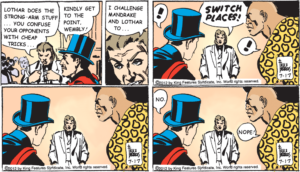
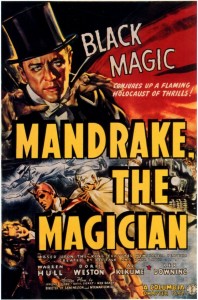
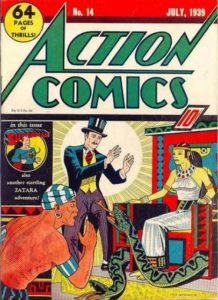
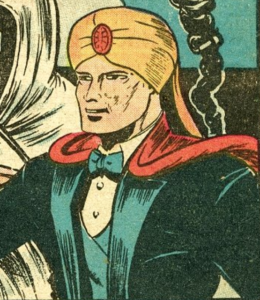
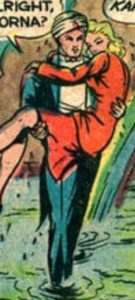
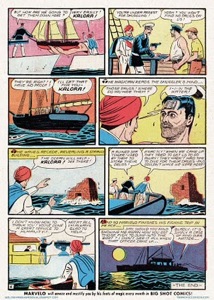

Comments are closed.